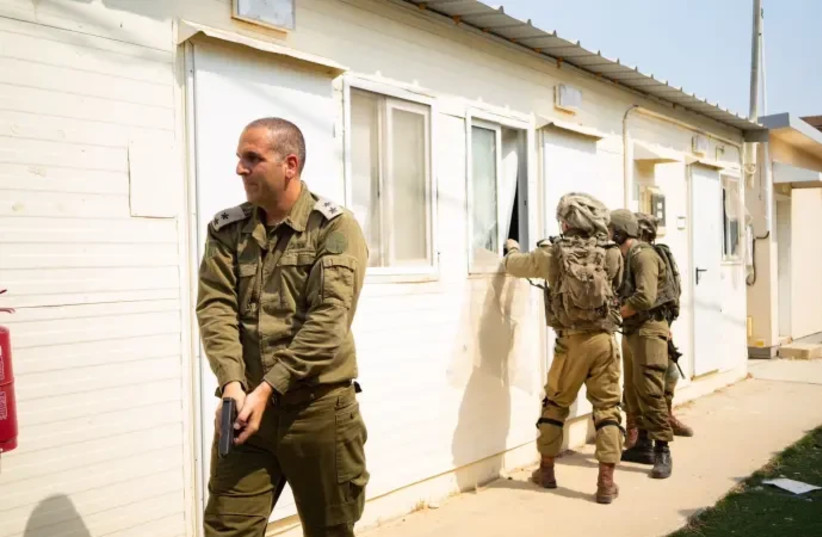Capt. Amit is ready for the next phase of the battle in Gaza. An officer in the Givati Brigade, he commands a company of soldiers. Those men are now training at an urban warfare facility. Driving to the facility one comes to an area run by Elbit Systems, one of Israel’s largest defence companies. Private companies play a key role in making the Israeli army ready for the future battlefield. Givati brigade members are going through the paces preparing to clear urban areas that they might encounter in Gaza. This is highly relevant because overnight between October 25 and 26 the Givati members with tanks and other vehicles, entered Gaza for a raid.
Earlier this week I drove to a firing range in central Israel, near Nahal Sorek. The rolling hills here are part of the Shfela, the area of Israel that is cut into small valleys and rolling hills. It sits between the coastal plain and the hill country. It is here that Capt. Amit was working with his soldiers. His full name cannot be used for security reasons.
He discussed the importance of the recent training. He said his unit has been there several days. Reservists are also present, carrying their M-4 rifles and Negev machine guns. The Givati guys have Tavor rifles. Every soldier has all the gear they need and they are motivated. Some sport mustaches, a new trend in the IDF. These shooting ranges are often used by special forces for training. Now regular infantry are going through the refresher course for the next phase.
“It’s about preparation if you are preparing for long operations you need to train for that,” says the Givati officer. His unit is part of the Tzabar battalion, one of three battalions in the brigade. This unit was in Protective Edge and other operations and has a long history in the IDF.
Amit has a story to tell about the war. As they prepare for the next phase he remembers October 7 when Hamas attacked. Like many Israelis he was sleeping and looking forward to a nice weekend when it happened. He was staying near the Sea of Galilee when he heard about the sirens sounding across southern and central Israel. He took his personal weapon and decided to drive towards Gaza, sensing something bad was happening. He drove through Tel Aviv around 9 in the morning. Eventually he got to Sderot. By this time the Givati brigade was activating its units that were stationed in the Golan. Men were getting rifles and preparing for battle.


Updates on the way
Amit spoke to another officer in the unit and they headed south. On the radio they heard about the disaster unfolding. In Sderot he saw the first evidence of the terrorist attack. There were dead terrorists who had attacked the city. Police in Sderot had neutralized some of the first wave of attackers. Others were under siege in the police station. Amit decided to drive toward a more acute site, the Reim parking lot for the Nova festival where hundreds of people were being massacred. When he arrived he saw other forces, many of whom also arrived in private cars. There were elite forces from the Yamam. There were many dead bodies he remembers.
The Givati officer now split up from the deputy commander of the unit, who was driving with him. They now began to understand how bad the situation was. Terrorists had attacked at 29 locations and overwhelmed the infantry units of Golani that were on the border. They were massacring civilians. However, by around noon as more soldiers arrived and more people came who had been reservists, the IDF had enough fighters to take the fight to the enemy. Amit and his fellow men got more weapons, including Negev machine guns, and participated in the battles to liberate Israeli communities. They went to Kibbutz Reim. Nearby the Gaza division headquarters had been attacked.
Along the way they saw a police vehicle that had been blown up. They also went to Kfar Aza to help in the fighting there. By now they had around 10-20 fighters with them. They went house to house and helped save people from shelters. They made sure that each civilian would be taken to safety with soldiers, in a kind of cordon.
He says the terrorists were in a trance, like on drugs. It has been revealed now some had taken Captogan, a drug. They had also been involved in an orgy of mass killing. The challenge taking the fight to the terrorists was also complicated by the presence of so many civilians and terrorists and various IDF units in the same place. It was hard to bring air power into the battle and use the techniques that Israel has trained for because of the setting.
Ever since the battle the members of Givati have been training hard for the next stage.
“I don’t know what caused me to go south but I was right,” he recalls. What was shocking was to see the size of the attack. It is now known some 2,900 people from Gaza, many of them terrorists, but some of them civilians seeking to loot, entered Israel on October 7. “We are now ready for everything that will happen and learning about the enemy and we are preparing to go in. We are as prepared as possible. I am ready to go.”
